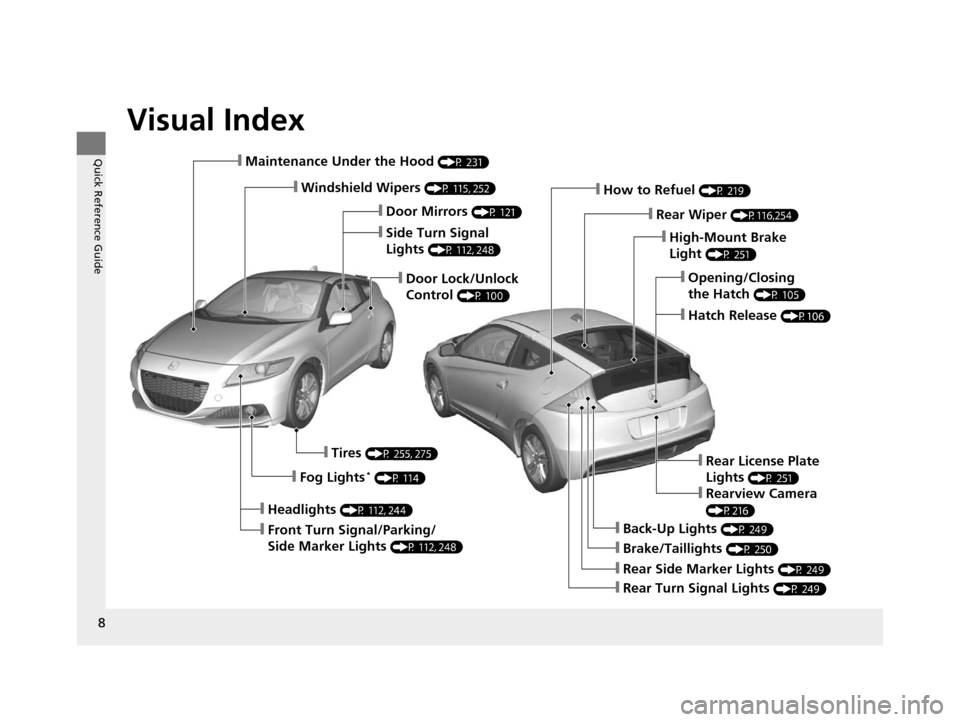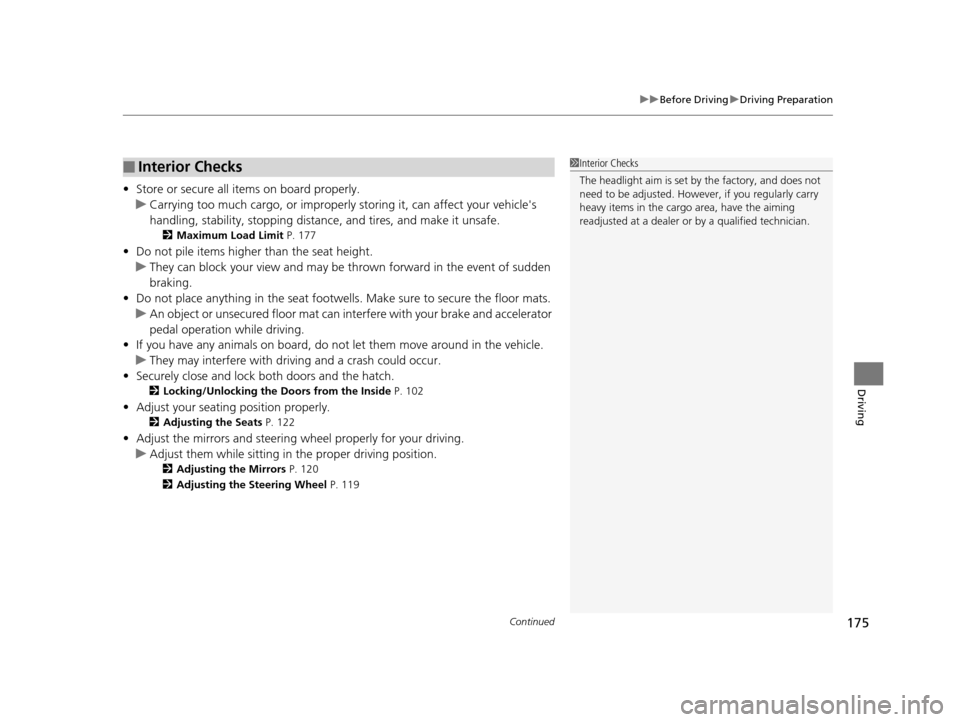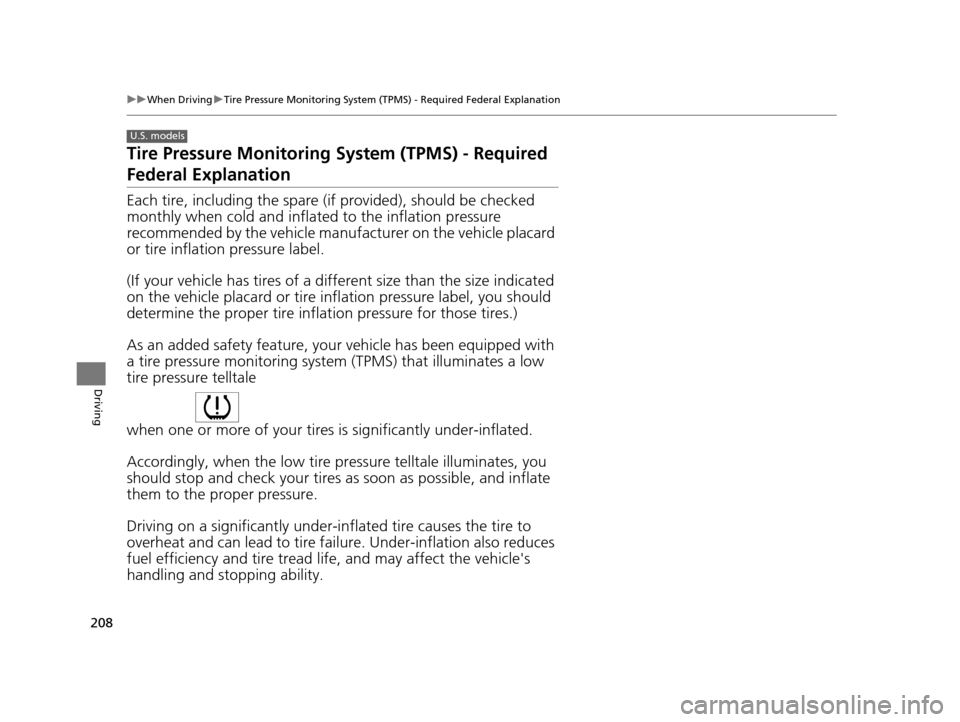2015 HONDA CR-Z tires
[x] Cancel search: tiresPage 4 of 329

Contents
Child Safety P. 54Exhaust Gas Hazard P. 62Safety Labels P. 63
Opening and Closing the Hatch P. 105 Security System P. 107 Opening and Closing the Windows P. 109
Adjusting the Mirrors P. 120 Adjusting the Seats P. 122
Climate Control System P. 136
General Information on the Audio System P. 157 Bluetooth® HandsFreeLink ® P. 160
When Driving P. 180 Braking P. 210Parking Your Vehicle P. 214
Rearview Camera P. 216
Accessories and Modifications P. 222
Maintenance Under the Hood P. 231 Replacing Light Bulbs P. 244
Checking and Maintaining Tires P. 255 12 Volt Battery P. 264 Remote Transmitter Care P. 266
Cleaning P. 268
Engine Does Not Start P. 290 Jump Starting P. 291 Shift Lever Does Not Move P. 293
Fuses P. 301 Emergency Towing P. 305When You Cannot Open the Hatch P. 307
Devices that Emit Radio Waves P. 313 Reporting Safety Defects P. 314
Authorized Manuals P. 319 Customer Service Information P. 320
Quick Reference GuideP. 4
Safe DrivingP. 27
Instrument PanelP. 65
ControlsP. 97
FeaturesP. 139
DrivingP. 173
MaintenanceP. 223
Handling the UnexpectedP. 273
InformationP. 309
IndexP. 321
15 CR-Z-31SZT6400.book 3 ページ 2014年8月1日 金曜日 午後1時59分
Page 9 of 329

Visual Index
8
Quick Reference Guide❙Maintenance Under the Hood (P 231)
❙Windshield Wipers (P 115, 252)
❙Door Lock/Unlock
Control
(P 100)
❙Headlights (P 112, 244)
❙Front Turn Signal/Parking/
Side Marker Lights
(P 112, 248)
❙Tires (P 255, 275)
❙Fog Lights* (P 114)
❙Brake/Taillights (P 250)
❙Back-Up Lights (P 249)
❙Rear Turn Signal Lights (P 249)
❙Rear Side Marker Lights (P 249)
❙High-Mount Brake
Light
(P 251)
❙How to Refuel (P 219)
❙Rear Wiper (P116,254)
❙Opening/Closing
the Hatch
(P 105)
❙Hatch Release (P106)
❙Side Turn Signal
Lights
(P 112, 248)
❙Door Mirrors (P 121)
❙Rear License Plate
Lights
(P 251)
❙Rearview Camera
(P216)
15 CR-Z-31SZT6400.book 8 ページ 2014年8月1日 金曜日 午後1時59分
Page 24 of 329

23
Quick Reference Guide
Maintenance (P223)
Under the Hood (P231)
● Check engine oil, engine coolant, and window washer fluid.
Add when necessary.
● Check transmission fluid (Continuously Variable Transmission).
● Check brake fluid and clutch fluid.
● Check the 12 volt battery condition monthly.
aPull the hood release handle under the corner of the
dashboard.
bLocate the hood latch lever, pull the lever up, and lift up
the hood.
cWhen finished, close the hood and make sure it is firmly
locked in place.
Lights (P244)
● Inspect all lights regularly.
Wiper Blades (P252)
● Replace blades if they leave streaks
across the windshield.
Tires (P255)
● Inspect tires and wheels regularly.
● Check tire pressures regularly.
● Install snow tires for winter driving.
15 CR-Z-31SZT6400.book 23 ページ 2014年8月1日 金曜日 午後1時59分
Page 72 of 329

71
uuIndicators u
Continued
Instrument Panel
IndicatorNameOn/BlinkingExplanationMessage
Electric Power
Steering (EPS)
System
Indicator●Comes on when you turn the
ignition switch to ON
(w, and
goes off when the engine starts.
●Comes on if there is a problem
with the EPS system.
●Stays on constantly or does not come
on at all - Have your vehicle checked by
a dealer.
2 If the Electric Power Steering (EPS)
System Indicator Comes On P. 299
Low Tire
Pressure/TPMS
Indicator
●Comes on for a few seconds when
you turn the ignition switch to ON
(w.●Comes on if the tire pressure of
any of the tires becomes
significantly low.
●Blinks for about one minute, and
then stays on if there is a problem
with the TPMS, or when a
compact spare tire
* is temporarily
installed.
●Comes on while driving - Stop in a
safe place, check tire pressures, and
inflate the tire(s) if necessary.
●Blinks and remains on - Have your
vehicle checked by a dealer. If the vehicle
is fitted with a compact spare, get your
regular tire repaired or replaced and put
back on your vehicle as soon as you can.
U.S.
models
only
* Not available on all models
15 CR-Z-31SZT6400.book 71 ページ 2014年8月1日 金曜日 午後1時59分
Page 175 of 329

174
Driving
Before Driving
Driving Preparation
Check the following items before you start driving.
• Make sure there are no obstructions on th e windows, door mirrors, exterior
lights, or other parts of the vehicle.
u Remove any frost, snow, or ice.
u Remove any snow on the roof, as this can slip down and obstruct your field of
vision while driving. If frozen solid , remove ice once it has softened.
u When removing ice from around the wheel s, be sure not to damage the wheel
or wheel components.
• Make sure the hood is securely closed.
u If the hood opens while driving, your front view will be blocked.
• Make sure the tires are in good condition.
u Check air pressures, and check for damage and excessive wear.
2Checking and Maintaining Tires P. 255
•Make sure there are no people or ob jects behind or around the vehicle.
u There are blind spots from the inside.
■Exterior Checks1Exterior Checks
NOTICE
When doors are frozen s hut, use warm water around
the door edges to melt any ice. Do not try to force
them open, as this can damage the rubber trim
around the doors. When done, wipe dry to avoid
further freezing.
Do not pour warm water into the key cylinder.
You will be unable to insert the key if the water
freezes in the hole.
Heat from the engine and exhaust can ignite
flammable material s left under the hood, causing a
fire. If you've parked y our vehicle for an extended
period, inspect and remove any debris that may have
collected, such as dried grass and leaves that have
fallen or have been carried in for use as a nest by a
small animal.
Also check under the hood fo r leftover flammable
materials after you or so meone else has performed
maintenance on your vehicle.
15 CR-Z-31SZT6400.book 174 ページ 2014年8月1日 金曜日 午後1時59分
Page 176 of 329

Continued175
uuBefore Driving uDriving Preparation
Driving
• Store or secure all items on board properly.
u Carrying too much cargo, or improperly storing it, can affect your vehicle's
handling, stability, sto pping distance, and tires, and make it unsafe.
2Maximum Load Limit P. 177
•Do not pile items higher than the seat height.
u They can block your view and may be thrown forward in the event of sudden
braking.
• Do not place anything in the seat footwells. Make sure to secure the floor mats.
u An object or unsecured floor mat can in terfere with your brake and accelerator
pedal operation while driving.
• If you have any animals on board, do not let them move around in the vehicle.
u They may interfere with driv ing and a crash could occur.
• Securely close and lock both doors and the hatch.
2 Locking/Unlocking the Doors from the Inside P. 102
•Adjust your seating position properly.
2 Adjusting the Seats P. 122
•Adjust the mirrors and steering wh eel properly for your driving.
u Adjust them while sitting in the proper driving position.
2 Adjusting the Mirrors P. 120
2 Adjusting the Steering Wheel P. 119
■Interior Checks1Interior Checks
The headlight aim is set by the factory, and does not
need to be adjusted. Howeve r, if you regularly carry
heavy items in the cargo area, have the aiming
readjusted at a dealer or by a qualified technician.
15 CR-Z-31SZT6400.book 175 ページ 2014年8月1日 金曜日 午後1時59分
Page 188 of 329

Continued187
uuWhen Driving uShifting
Driving
Use the paddle shifters to change betw een 1st and 7th speeds without removing
your hands from the steering wheel. The transmission switches to the 7-speed
manual shift mode when you pull a paddle shifter while driving. This mode is useful
when engine braking is needed.
You can cancel this mode by pressing any of the three driving mode buttons, or
pulling the
(+ paddle shifter for a few seconds.
■When the driving mode is in ECON or NORMAL
The shift mode goes into the 7-speed ma nual shift mode temporarily, and the
number is displayed in the shift indicator.
The 7-speed manual shift mode is canceled automatically if you drive at constant
speed or accelerate, and the number in the shift indicator goes off.
The 7-speed manual shift mode is especially useful when reducing the vehicle speed
temporarily before making a turn.
■When the driving mode is in SPORT
The shift mode goes into the 7-speed manual shift mode. The M indicator and the
speed number are displayed in the shift indicator. As the vehicle speed slows down,
the transmission automatically shifts down accordingly. When the vehicle comes to
a stop, it automatically shifts down into 1st.
If the vehicle speed increases and the engi ne speed reaches near the tachometer’s
red zone, the transmission automatically shifts up.
■7-Speed Manual Shift Mode1 7-Speed Manual Shift Mode
To improve fuel economy, the transmission may shift
up to a higher speed than the seventh under certain
circumstances. In this case, the number in the shift
indicator remains as 7.
In the 7-speed manual shif t mode, the transmission
shifts up or down by operating either paddle shifter
under the following conditions:
Shift Up: The engine sp eed reaches the lowest
threshold of the hi gher speed position.
Shift Down: The engine sp eed reaches the highest
threshold of the lower speed position.
When the engine speed reaches near the
tachometer’s red zone, the transmission shifts up
automatically.
When the engine speed reaches the lowest threshold
of the selected speed positi on, the transmission shifts
down automatically.
Operating the paddle shifte rs on slippery surfaces
may cause the tires to lock up. In this case, the 7-
speed manual shift mode is canceled and goes back
to the normal D driving mode.
15 CR-Z-31SZT6400.book 187 ページ 2014年8月1日 金曜日 午後1時59分
Page 209 of 329

208
uuWhen Driving uTire Pressure Monitoring System (TPMS) - Required Federal Explanation
Driving
Tire Pressure Monitoring System (TPMS) - Required
Federal Explanation
Each tire, including the spare (i f provided), should be checked
monthly when cold and inflated to the inflation pressure
recommended by the vehicle manufacturer on the vehicle placard
or tire inflation pressure label.
(If your vehicle has tires of a different size than the size indicated
on the vehicle placard or tire infl ation pressure label, you should
determine the proper tire inflat ion pressure for those tires.)
As an added safety feature, your vehicle has been equipped with
a tire pressure monitoring system (TPMS) that illuminates a low
tire pressure telltale
when one or more of your tire s is significantly under-inflated.
Accordingly, when the low tire pr essure telltale illuminates, you
should stop and check your tires as soon as possible, and inflate
them to the proper pressure.
Driving on a significantly under-in flated tire causes the tire to
overheat and can lead to tire fail ure. Under-inflation also reduces
fuel efficiency and tire tread li fe, and may affect the vehicle's
handling and stopping ability.
U.S. models
15 CR-Z-31SZT6400.book 208 ページ 2014年8月1日 金曜日 午後1時59分